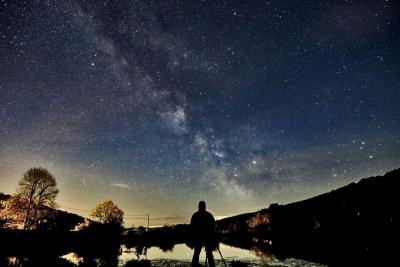Stage One Astronomy
Introduction

Go outside on a dark, cloudless night. Preferably away from any bright sources of artificial light and look up at the sky. What do you see? The Moon perhaps, stars, some twinkling, some faint. Maybe, one of them is a planet, but which one. What is the difference between a star and a planet? A brief flash of light streaks across the sky – a meteor! What is it? Where did it originate? Towards the west, a point of light moves slowly across the sky before fading in the east, an artificial satellite, perhaps the International Space Station. What about unpredictable phenomena such as bright comets and aurora?
We have selected a range of articles to supply you with useful information,
hints and tips, together with some observational challenges for all
levels of experience.
The British Astronomical Association (BAA) is the UK’s premier organisation for the amateur observer; We have created this site to give you the skills to get out in the evening and become one with the night sky.
These pages are an evolving resource, so please check back from time to time, to see what is new
(Image:Martin Griffiths, taken at Stokes Castle, Ludlow, 23/05/2017)
Categories
Our Solar System |
Our planetary system is located in the Orion Spur which is part of one of the four outer spiral arm of the Milky Way galaxy. The solar system consists of our star, the Sun, and everything bound to it by gravity, which includes the planets Mercury, Venus, Earth, Mars, Jupiter, Saturn, Uranus and Neptune, dwarf planets such as Pluto, dozens of moons and millions of asteroids, comets and meteoroids. If you would like to learn more about our Solar System. Select here |
|
Constellations |
Ever since people first wandered the Earth, great significance has been given to the celestial objects seen in the sky. Throughout human history and across many different cultures, names and mythical stories have been attributed to the star patterns in the night sky, thus giving birth to what we know as constellations. If you would like to learn more about Constellations. Select here |
|
Milky Way Galaxy |
The Milky Way Galaxy, is a large spiral system consisting of several hundred billion stars, one of which is the Sun. It takes its name from the Milky Way, the irregular luminous band of stars and gas clouds that stretches across the sky as seen from Earth. If you would like to learn more about our Galaxy. Select here |
|
Deep Sky |
Deep-sky objects are celestial objects that exist outside our solar system. Three major types of deep-sky objects are nebulae, star clusters, and galaxies. If you would like to learn more about Deep Sky. Select here |
|
Equipment and Techniques |
If you would like to learn more about Equpment and Tachniques. Select here | |
To return to the Tutorial Showcase home page. Select here
| The British Astronomical Association supports amateur astronomers around the UK and the rest of the world. Find out more about the BAA or join us. |
